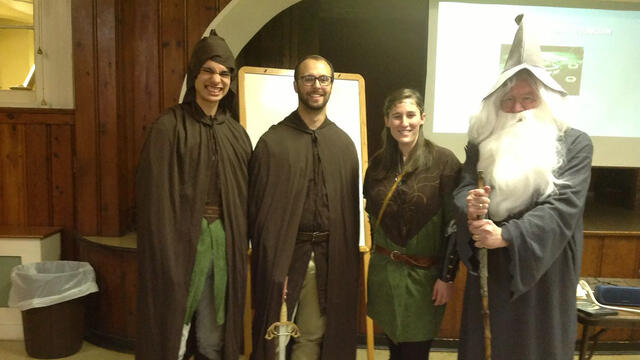Students present analysis of ‘Lord of the Rings’ at Jungian meeting
Dressed as a wizard, an elf, a king and an elf princess from “Lord of the Rings,” three students and Psychology professor Paul Mazeroff enchanted the Baltimore Jungian Working Group with their analyses of different elements of Tolkien’s classic in terms of the psychology of Carl Jung.

Dressed as a wizard, an elf, a king and an elf princess from “Lord of the Rings,” three students and Psychology professor Paul Mazeroff enchanted the Baltimore Jungian Working Group with their analyses of different elements of Tolkien’s classic in terms of the psychology of Carl Jung.
Dressed as a wizard, an elf, a king and an elf princess from “Lord of the Rings,” three students and Psychology professor Paul Mazeroff enchanted the Baltimore Jungian Working Group with their analyses of different elements of Tolkien’s classic in terms of the psychology of Carl Jung.
The annual three-hour presentation by McDaniel students has earned its place as one of the group’s favorite events as each year Mazeroff and a group of students explore how Jungian archetypes in clinical psychology apply to modern works such as “Harry Potter,” “The Wizard of Oz,” “The Lion King,” James Joyce’s “Ulysses” and Wagner’s “The Ring of the Nibelung,” A Swiss psychiatrist, Jung took a psychodynamic approach, believing that the unconscious plays an important role in determining behavior and emotions, Mazeroff says.
Jung also believed that people had both a personal and a collective unconscious, the latter consisting of the energy and memories of experiences of the human race, such as having parents, seeking a mate and becoming independent. These experiences manifested in what he called archetypes of the collective unconscious such as the evil stepmother, the wise old man, the great earth mother.
Against these psychological theories and dressed for their roles — in the deep red-and-gold striped Gryffindor scarves of Hogwarts Academy for Harry Potter, horned helmets for Valkyries, medieval garb of the Hobbits’ Middle-earth — students and mentor presented their analyses to the Jungian group in Baltimore.
Mazeroff’s popular “Madness, Genius and Creativity” and “The Hero’s Journey” courses, as well as the Psychology courses he teaches, regularly turn up students perfect for the independent study. This year was no exception as Environmental Studies and French major Jason Swartz, Kinesiology and Spanish major Christina DeJoseph and Philosophy and Psychology major Gavin Gibson eagerly accepted his invitation to flex their critical thinking skills by delving deep into a world inhabited by Tolkien’s characters and images.
“It felt like the epitome of the liberal arts — interdisciplinary, new topics and the freedom to explore,” says DeJoseph, a senior from Palmyra, N.J., who focused on trees as archetypes of different levels of consciousness as well as examples of what happens when nature takes a backseat to industry. “One of the concepts I found was the relationship between the conscious, unconscious and ego with the tree’s roots representing the unconscious, the trunk as the conscious and the branches reaching to the heavens as the ego.”
Mazeroff and Gibson, the only Psychology major among them, examined the hero, Frodo. Gibson, a junior from Newark, Del., was already familiar with Carl Jung and looked at how the different Jungian personality types of Frodo and his best friend Sam influenced their mission to find the ring.
“Frodo makes decisions through logical or objective evaluation while Sam bases his decisions on his feelings,” says Gibson, explaining that as Frodo’s objectivity becomes clouded by “the ring,” he tends to rely on his feelings. “Jung wrote a lot about personality theory and it was a large part of his psychology so Frodo and Sam were perfect characters to analyze through Jung’s lens.”
Mazeroff, who is a licensed psychologist, looked at Frodo’s journey and explained that he manifested the symptoms of Post-Traumatic Stress Disorder (PTSD).
“Frodo’s journey, and the wounds he experiences, provide a useful model for helping therapists (who constituted the majority of the audience) and trauma survivors make sense of the healing process,” Mazeroff says.
Swartz of Dillsburg, Pa., didn’t hesitate in accepting Mazeroff’s invitation to join the independent study group. He looked at hobbits broadly, relating them to the collective unconscious — “shared things we know but don’t know we know,” Swartz says as he face-timed from the Environmental Studies lab where he is doing his capstone research.
“I thought it would be fun — even as a senior it’s not too late to try something new, then to learn and connect that to your major.”
McDaniel students (l. to r.) Gavin Gibson, Jason Swartz and Christina DeJoseph with Psychology professor Paul Mazeroff dressed as characters from Tolkien's "Lord of the Rings" to present their analysis to Baltimore's Jungian Working Group.